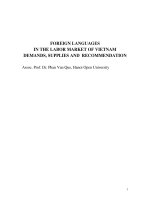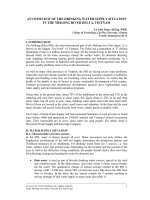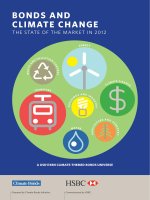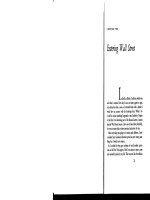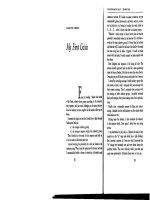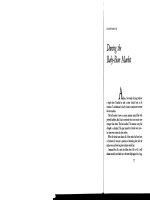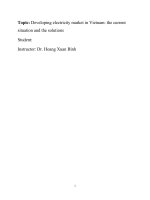The Oil Market In Vietnam.pdf
Bạn đang xem bản rút gọn của tài liệu. Xem và tải ngay bản đầy đủ của tài liệu tại đây (14.78 MB, 17 trang )
<span class="text_page_counter">Trang 1</span><div class="page_container" data-page="1">
<b>CLASS: IB1612COURSE: IBC201</b>
<b>LECTURER: Bui Thi Thu Huyen</b>
<b>Tran Minh Tri - HS163411Nguyen Thi Hoa - HS160870Pham Quang Anh - HS160892</b>
Group 3
<b>Hanoi | 2 Jul 2022</b>
THE OIL MARKET IN VIETNAM
<b>Duong Thi Kieu Trang - HS163327Mai Thi Hong Nhung - HS163391Nguyen Minh Anh - HS160881</b>
</div><span class="text_page_counter">Trang 2</span><div class="page_container" data-page="2">Revenue and market share of petroleum ...
Revenue from exporting Vietnam's crudeoil to foreign countries ...
Current import of Vietnam's demand ...
Opportunities and challenges for theVietnam oil market...
Negotiating strategy to import petroleumat better prices ...
11121516
</div><span class="text_page_counter">Trang 3</span><div class="page_container" data-page="3">Petroleum is one of the three main commoditiesthe State pays special attention to in Vietnam. Itis the source of input materials for mostmanufacturing industries and is indispensable inlife. Just a small change in gasoline can greatlyaffect other activities in society.
Prices and petroleum markets in the world from2020 to now have fluctuated very strongly. Inparticular, in recent times, petroleum supply anddemand have been imbalanced and affected bythe military conflict between Russia and Ukraine.The sharp fluctuation of world gasoline pricesmakes the retail price of petrol in Vietnam alsofluctuate and poses some problems to the currentpolicy of petrol price management in Vietnam. With the guaranteed supply of petrol and oilalong with market inspection and control andflexible gasoline and oil price management, theMinistry of Industry and Trade affirmed that itwould ensure a continuous supply of petrol and oilto the market. in the country, serving production,business, and consumption of people andbusinesses in the coming time.
</div><span class="text_page_counter">Trang 4</span><div class="page_container" data-page="4"><b>Revenue and marketshare of petroleum</b>
<b>Market share</b>
Vietnam currently has two oil refineries,Dung Quat and Nghi Son, supplying 10-13million m3 each year, tons of gasoline,and finished oil of all kinds. These twofactories currently supply about 70% ofthe domestic demand for gasoline and oil,of which the supply proportion of NghiSon is about 35%, sometimes up to 40%. In addition, there are a number ofcondensate gas plants such as PVOil PhuMy, Dong Phuong, and Saigon Petro, etcwith a production capacity of over600,000 m3, tons a year.
With the country's annualconsumption demand of20.5-21 million m3, tons, thesupply from domesticproduction meets 70% ofthe national consumptiondemand, so the remaining30% of demand still has toimport finished petroleumproducts from countries. Last year, while thedomestic petroleum supplycould only meet 70%,Vietnam still had to export3.1 million tons of crude oiland then import nearly 10million tons of oil.
<b>Vietnam fuel supply (unit: million tons)</b>
</div><span class="text_page_counter">Trang 5</span><div class="page_container" data-page="5"><b>Crude oil exploitation is decreasing day by day</b>
In 2021, Vietnam will exploit nearly 11 million tons of crude oil, of which 9.1 million tons will come fromdomestic fields, and nearly 1.9 million tons will be extracted from foreign fields that PVN (Petrovietnam)cooperates with private. In the past 6 years, domestic production has been continuously decreasing. Onaverage, production has decreased by one million tons per year.
The decrease was mainly due to asharp decrease in domestic exploitation.Crude oil extraction is more and moredifficult than before because theincrease in reserves (finding, exploration,and extraction of oil and gas in newfields or pools to compensate for annualproduction) has decreased significantly.For example, if converted into oil, theincrease in reserves reached 40.5 million
tons in 2015, then three years later it will be 12 million and in 2021 it will be 4.6 million tons. In addition, newly discovered oil and gas are also on a downward trend. If in the period 2011-2015 there were 24 newoil and gas discoveries, then 5 years later there were only 7, at the fields of Ken Bau, Soi Vang, MeoTrang Dong, etc.
Newly signed oil and gas contracts or investment of resources for search and exploration alsodecreased compared to the previous period. According to the Ministry of Industry and Trade, only 3 newcontracts were signed in 2016-2020, down 7 times compared to the previous 5 years. At the main oil andgas fields (Bach Ho, Su Tu Den, Su Tu Vang...), the exploitation is in the stage of production reduction orhigh water level, potentially risky. The recently discovered mines are small in scale, located in complexgeological and geographical areas, in difficult-to-access deep-water areas, and require largeinvestments and high risks.
</div><span class="text_page_counter">Trang 6</span><div class="page_container" data-page="6">Share of revenue from crude oil in the budget
In the first four months of this year, PVN exploited more than 3.6 million tons of crude oil. Thanks to theincrease in crude oil prices on the world market, the budget revenue from crude oil sales in April reachedVND 6,600 billion. Accumulated in the first 4 months, this amount reached VND 24,100 billion, nearlydoubled in the same period and equal to 85% of the year estimate.
PVN said that over the past time, this unit has achieved very positivefinancial targets, continued its growth momentum, and significantlycontributed to the state budget. In the first 5 months of 2022, theGroup's total revenue from products such as oil, petrol, electricity, gas,protein, etc was about VND 372,000 billion - an increase of 58% over thesame period in 2021; contributing about VND 52,800 billion to the statebudget, up 59% over the same period in 2021.
</div><span class="text_page_counter">Trang 7</span><div class="page_container" data-page="7">Year 2005 2008 2009 2010 2011 2012 2013 2014 2015Crude oil 26.41 21.42 14.56 9.37 10.36 9.70 7.21 4.79 2.34Footwear 10.89 9.87 9.57 9.55 9.37 8.58 8.38 6.81 7.39Textiles 17.10 18.87 21.31 20.90 18.91 17.04 17.90 13.84 13.93Fisheries 9.79 9.33 10.00 9.36 8.75 7.20 6.68 5.24 4.06Other 35.81 40.51 44.56 50.82 52.61 57.48 59.83 69.32 72.28
It has traditionally accounted for a considerable percentage ofVietnam's export value when compared to other key export items suchas footwear, textiles and apparel, and fisheries. Table 1 illustrates theexport value shares (expressed in million USD) of several of Vietnam'skey goods in 2005 and from 2008 to 2015. Besides, the next chart belowshows the value of crude oil exports in Vietnam from 2011 to 2020(expressed in million USD).
In 2005, crude exporting accounted for 26.41% of Vietnam’s totalexports and reached 7.37 billion USD. In 2008, the figure was 10.36billion USD, which was equivalent to 21.42% of total exports but then felldown to just only 3.806 billion USD in 2015 (or 2.34%). In 2020, the valueof crude oil exports from Vietnam only reached 1.57 billion USD.
Table 1. Export value of major products (unit: %)
| Source: 2011 and 2015 Statistical Yearbook |
</div><span class="text_page_counter">Trang 8</span><div class="page_container" data-page="8">Value of crude oil exports in Vietnam from 2011 to 2020 (unit: million USD)
The data showed that crude oil exportvalue in the country had been decreasingdrastically in the last decade. There aretwo reasons for the decrease in crude oilexport value in recent years. For one thing,it is the decline of production in largefields, especially Bach Ho field. For anotherthing, in 2009 Dung Quat Refinery wentonline and consumed a significant amountof domestic crude oil. Despite this, crude oilwas still important in the total export value
of the country. Expansion of Dung Quat Refinery
</div><span class="text_page_counter">Trang 9</span><div class="page_container" data-page="9">In 2022, Nghi Son Refinery will cut capacity because of financialdifficulties, causing imported petroleum output to increase.According to data from the General Department of Customs onimport and export turnover, in the whole first quarter, the wholecountry imported 2.66 million tons of petrol and oil with a value of$2.45 billion, up 26.8% in volume and increased sharply by 128.5%in value over the same period in 2021. In fact, now the world oilprice is continuously above 100 USD/barrel, sometimes surpassing120 USD/barrel in the context of local tensions politics in EasternEurope have pushed up the price of petroleum products.
Current import of Vietnam's demand
On average, over the past five years (2015-2020), each year,Vietnam imports $5,568 billion of finished petroleum products of allkinds. Finished petroleum import markets are markets whereVietnam can take advantage of import tax incentives from signedfree trade agreements such as Singapore, Malaysia, Thailand,Korea, China, etc. Although the number of oil imports hasdecreased significantly since 2021, the world oil price tends toincrease, so the amount of money spent to import is more than inprevious years.
The amount of money Vietnam has to spend to import finished oil (billion USD)
</div><span class="text_page_counter">Trang 10</span><div class="page_container" data-page="10">In theory, with no import, no tax, no shipping fees, and many othertaxes and fees, the price of gasoline may decrease. Besides, it alsosolves the situation of petroleum inventories from the Covid-19pandemic.
Oil refineries in Vietnam have the advantage of abundant crude oilsupply, the difference between quality crude oil and sour oil is notmuch.
In terms of policy, Vietnam is increasingly integrating deeply withthe world, so investment opportunities both at home and abroadare more open.
According to BSR news, in the context that many large oilrefineries in the world are having to reduce their operatingcapacity due to external factors such as the shortage of crude oil,the Dung Quat Refinery has always operated efficiently at 105%capacity.
BSR's own development opportunity is a potential petrochemicalproduct market, Dung Quat Refinery configuration is open, andcan diversify products, and develop petrochemical products.
Opportunities and challenges for the Vietnam oil market
The domestic source of sweet crude oil is decreasing in volume andquality. In particular, the diversification of products when the market'srequirements are increasingly high in terms of types and quality.The growing trend of adopting electric cars, together with theadvancement of technology, reduces the demand for petroleumproducts.
With the trend of tightening environmental requirements for dischargesources, projects must increase investment in treatment to ensureenvironmental requirements.
In the face of fluctuations in world oil prices over the past time, diversifying oil sources is also a bigchallenge for oil refineries in ensuring cheap, stable oil purchases and quality service to customers'machines.
For the petrochemical industry in Vietnam today: There are not enough mechanisms to do so, so fewpeople dare to invest. In addition, tax challenges abound. The most important condition is that theGovernment needs to remove the mechanism to disburse cash flows quickly and legally so thatbusinesses can work with peace of mind.
If we stop or ban the import, it also means that we ban other countries from exporting petroleum toVietnam and may violate international commitments in trade agreements, WTO that Vietnam joins andsigns.
</div><span class="text_page_counter">Trang 11</span><div class="page_container" data-page="11">Negotiating strategy to importpetroleum at better prices
In terms of petroleum products, it is a necessary importitem to ensure energy security. Vietnam's partners aremainly from the ASEAN region. Singapore, Malaysia,Korea, etc. One of the factors that make up the price ofgasoline is supply, demand, and taxes.
Currently, in Vietnam, we have a very large demandand a lack of supply, which has led to a recent sharpincrease in gasoline prices. Vietnam has 2 petroleumprocessing plants that supply 75% of the domesticmarket, the rest of Vietnam continues to import gasolineto ensure supply. From there, we must have strategies tonegotiate with partners to stabilize gasoline prices. The strategies can be mentioned such as signingpurchase and sale cooperation in a period of time andbuying in large quantities. Negotiating internationalcommercial contracts, promoting trade, and exchangingregularly with negotiated prices. Based on the situation ofinternational relations, politics, war, and inflation level,Vietnam needs to discuss and consider carefully whennegotiating with partners.
For example, Vietnam recently, Vietnam importedpetroleum from Malaysia will import at a negotiated price.In the long run, it is necessary to consider more flexible taxtools, to take into account the reduction of environmentaltax, special consumption tax, value-added tax, and importtax, and to have a strategy of saving and graduallyconverting the tax system, especially taxes. The Ministry ofIndustry and Trade has presented to the National Assemblythe issue of petroleum import tax reduction from 20% to12% in order to diversify supply. The energy-use structure isslightly environmentally friendly.
Consequently, Vietnam needs a long-term strategy,especially creating a national strategic petroleum reserveto ensure the safety of energy and economic activities.
</div><span class="text_page_counter">Trang 12</span><div class="page_container" data-page="12">Negotiation plan
In the contract, governments want to determine how much they willget from their natural capital. There are two main objectives that mustbe determined: The method of profit sharing between the governmentand the partners. In this case, we want to increase the export price ofcrude oil and reduce the price of the import of the finished oil, and thepayment method. or recover their costs.
If the business of the Vietnamese government and foreign oil companies do not acceptthe condition of increasing the export price of crude oil and reducing the price of importedrefined oil, the Vietnamese government can choose the Malaysia market to continueexporting and importing crude oil. Because at present Malaysia still has a good traderelationship with Vietnam. So when choosing Malaysia as an import-export partner, Vietnamwill be able to take advantage of its secured position to conduct further negotiations on itsown with Western oil companies.
The Vietnamese government can conduct negotiations at a cheaper price for mutualbenefits. Specifically, Vietnam will increase the export price of crude oil by 11% in the next 6months and reduce the price of imported refined oil by 7%. If after 6 months, the situationremains unchanged, we will reduce the price of imported refined oil by 2% more. Because inthis case, continuing to increase crude oil prices is not a wise move for Vietnam, instead, alittle more profit will create more sympathy for Western companies and at the same timeincrease the value image of Vietnam.
</div><span class="text_page_counter">Trang 13</span><div class="page_container" data-page="13">- chances - chan
Assess components and the social context of the negotiation
In recent times because of the war situationin Ukraine, Western countries have had manyconflicts with one of the world's largest oilexporters, which is Russia. That makes gasolineand gas prices skyrocket because of the scarcityof supply. European countries are extremelyworried when their countries do not have fossilfuel resources to exploit, and there are only afew months left until winter if there is no oil orgas, it will become a big problem for them.
partner of Europe in petroleum import and export.In addition, when exporting a lot of oil to Europe,Vietnam's money is also appreciated.
Grasping that, Vietnam has many chances toenhance the image value of Vietnamesepetroleum products in the European market.Previously, we were a small and unremarkablemarket for foreign companies to pay attentionto. But based on the current shortage ofgasoline, it would be good if we could become a
In addition, when exporting more oil to Europe,Vietnam's money also increases in price.
